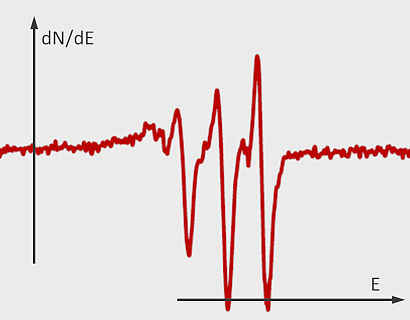Auger electron spectroscopy (AES)
Under bombardment with high-energy electrons (usually 3-5 keV), Auger electrons are emitted from the sample. Their energies are determined only by the differences between energy levels involved during the excitation (ionisation) and relaxation process and are a fingerprint of the chemical species. Auger electron spectroscopy is used to analyse the
- chemical composition at the surface.
Funded by the European Union as part of the European Regional Development Fund (ERDF) Infrastructure for Research, Development and Innovation (InfraFEI) programme. Details can be found on the project website InfraMOCha.
MethodOpen areaClose area
In Auger electron spectroscopy, electrons with energies in the range of a few keV ionise atoms by knocking out core-level electrons. The resulting core hole is filled by an electron from a higher energy state. In the Auger-Meitner effect, the energy difference is transferred to another electron that leaves the material and can be detected - the so-called Auger electron.
The energy carried by the Auger electron thus depends only on the energy levels involved and not on the energy of the exciting electron. These energies are element-specific, so that an analysis Auger electrons' energies allows determination of the chemical composition of the material. Due to the small escape depth of the Auger electrons in the order of 10 atomic layers, Auger electron spectroscopy is a surface-sensitive method.
SpecificationsOpen areaClose area
For AES, LEED optics are used in which only electrons of a certain energy can pass through by applying electrical voltages in an arrangement of four grids in front of the light screen.
- 4-grid LEED optics in reverse view design with µ-metal shielding
- Electron source: light-shielded miniature electron source with thoria-coated Ir hairpin filament
- Primary energy: 0 - 3 keV
- Detector energy: 0 - 2 keV
- Preamplifier, filter and matching unit
- Integrated lock-in amplifier
